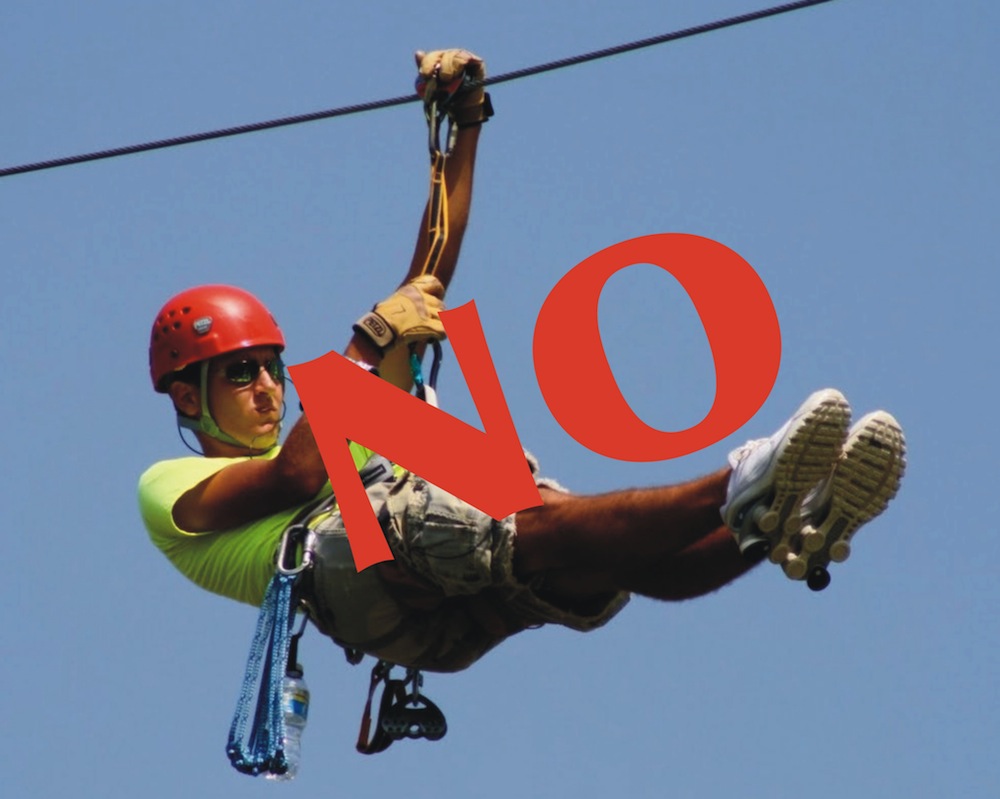What Part of “No” Does Crane Point Not Get?
Last week’s announcement that the Crane Point Nature Center would back away from a $ 727,000 federal grant via the city of Marathon and also give up a height variance allowing towers higher than what Marathon normally allows had opponents of the proposed zip-line attraction cheering.
Lost in the celebration, however, was Crane Point board member Norval Smith’s announcement that the board would pursue building a zip line on their own. The initial more limited plan includes eight towers, three zip lines and sky walks. It’s difficult to fathom the depth of the organization’s obtuseness and inability to look reality in the face.
Though Crane Point has removed the word “adventure” from the name of its newest plan, the word “canopy” remains. And that’s a huge problem.
“The issue with the zip lines was that human recreational activity in the canopy clearly would have unacceptable impacts on canopy-feeding birds,” said Dr. Kenneth Meyer, executive director of the Avian Research and Conservation Institute, who became involved with the zip-line opposition in 2011. “As wary as they are, most pigeons that would be affected by a zip line also would by a walkway. Leaving the canopy unviolated must be the goal of any activity planned for Crane Point.”
The reason that the city of Marathon decided to back away from the Community Development Block Grant is because of strong objections by US Fish and Wildlife’s Cindy Fury to a zip-line course on a property used by migrating birds. In addition, the department of Housing and Urban Development (HUD) has concerns about adherence to the Americans with Disabilities Act on the site. It has been reported to The Blue Paper that HUD has appointed an investigator to look at the site’s level of compliance.
Just because Crane Point is not getting federal money for their proposed project doesn’t make either issue go away and that’s what the Crane Point board and its chair, Marathon branch First State Bank loan officer Jeff Smith, don’t seem to get. The proposed plan is based on elements that can injure the state-listed threatened White-crowned Pigeon as it comes through the area to feed.
Fury, leader of the Florida Caribbean Migratory Bird Field Office of the U.S. Fish and Wildlife Service, in a long letter was quite specific about potential threats to the bird. Even with the scaled back version, her concerns still apply.
“The proposed zip line project will consist of hundreds of yards of cables that stretch through the canopy similar to a power line and could potentially result in pigeon mortality [emphasis added]. As the lines will actually be located within the canopy in only a 10-foot wide opening, they may be even less visible to pigeons than power lines in open areas, and could result in a greater incidence of direct take as the birds fly through the forest to forage and collide with the unseen cable. Take of pigeons resulting from collisions with human-constructed zip line cables or other structures could be a violation of the MBTA and State regulations.”
Fury’s recommendations are clear and even the city of Marathon, which had strongly supported the zip-line project for several years with all relevant boards voting nearly unanimously to proceed, got the message. At its last meeting, Marathon reversed its previous positions completely and voted 5-0 to return the grant money and rescind the height variance.
Fury wrote:
“The USFWS is not averse to zip line recreational opportunities in all areas, but we do have concerns regarding their use in rare habitats containing at-risk species. We strongly recommend that the zip line project not be approved and/or constructed within Crane Point Hammock due to: potential adverse impacts to the white-crowned pigeon and their habitat as outlined above and supported through literary documentation; lack of detailed information on the pigeon within Crane Point Hammock; lack of information on the extent of how this project could affect the white-crowned pigeon breeding population and habitat in Florida and the species range-wide; and the proximity , size, and quality of this important foraging habitat to the most productive pigeon nesting sites within the Keys.”
She went on in the letter to threaten legal action if any White-crowned pigeons were killed or injured by the installation or operation of structures in the canopy.
Board closes ranks
The Blue Paper has learned from a very reliable source that Crane Point’s board has hardened its position on installing zip lines on the property. Not only does everyone on the board now support the project but also the group has instituted what amounts to a loyalty oath, demanding that any new board member also support what they are calling the Eco-Canopy Tour. In addition, we have learned that the board rewrote its by-laws, having just done so in 2012. A member has requested a copy of the newest version, which is the right of any member. However, the last time this request was made, the member had to hire a lawyer to obtain the by-laws and instead of receiving all of them from the time of incorporation to the present received only the 2012 version. This time they are promising that she can have them.
It is further reported that board chair Jeff Smith has become dictatorial in his zeal to construct the tourist attraction on the site and will allow no dissension. Crane Point will apparently seek private funding to build the attraction in the face of these legal threats and the strong and continuing opposition of those who finally got the city to see reality. Sources in that group indicate they will go back to court if Crane Point persists.
What’s so odd about Crane Point is how secretive the organization has become. If you go to the group’s website and click on “contact us” you get a link to their address and the email and phone number of the director of operations Loretta Geotis. If you go to the website of, for example, the Key West Botanical Garden and click on “contact us” the names of all the officers of the organization and all the board members appear. Both are 501(c)3 non-profit organizations and both have obligations for reporting to the IRS about their status and finances.
Crane Point is so secretive that not only do they not reveal their board members but also won’t even provide their names if asked. Several members and former members (who resigned in protest about plans for the zip-line course) have requested this information and have been denied. It’s not clear why.
Opponents to the zip-line plan have been hoping to work with the organization to develop new ideas for raising money through efforts appropriate for a nature center, but that optimism has been dashed by Crane Point’s indications that it still believes that some form of a zip-line tourist attraction is the only way to save the struggling non-profit. And given its hardened position it doesn’t seem that any dialogue is possible.


It is obvious the Crane Point board has gone rogue, refusing to reveal the basic information that a non-profit membership organization is required to furnish. A cursory reading of the revised (Feb. 2012) bylaws reflects an attitude that is both arrogant and insular. New board members are nominated only by existing board members, and there is no longer an annual membership meeting to elect the board and interact with members. It appears the sole privilege of membership, besides admission to the Nature Center, is to give money.